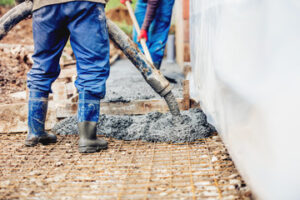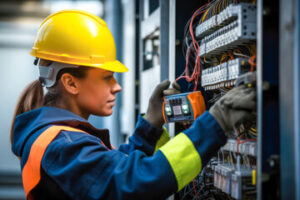Concrete Contractors Greensboro NC prioritize safety during construction. They follow strict safety protocols to minimize risks and protect their clients.

They understand the chemistry of concrete and know how to mix the best composition for the project requirements. This ensures longevity and durability.
They also know how to complete the work efficiently. This saves you time and money.
Having years of experience working with concrete, professional concrete contractors possess the technical knowledge and skills to manage any size or type of concrete construction project. They are also adept at handling challenging situations that may arise during construction, ensuring the project remains on track and avoiding costly mistakes that could derail the timeline and budget.
They understand the nuances and limitations of various types of concrete, and can recommend the best materials for your project. Concrete contractors also have specialized tools and equipment that can complete work more efficiently than the average DIYer, saving time and money. Plus, they have access to bulk materials and can secure discounts from suppliers that would be inaccessible to individual homeowners or small business owners.
When hiring a concrete contractor, make sure they have valid licenses appropriate for the scope of your project, as well as adequate insurance coverage to protect you in case of accidents or property damage during construction. You should also look for a contractor who prioritizes safety protocols and is familiar with the latest industry standards and regulations.
Expert concrete contractors are constantly exploring and adopting innovative techniques that enhance the quality of their work and improve the final product for clients. This is especially true when it comes to self-compacting concrete (SCC), which eliminates vibration during placement, allowing the concrete to flow into complex forms and around reinforcement evenly, reducing voids and promoting strength.
In addition to demonstrating technical expertise, top-rated concrete contractors have excellent customer service skills and are willing to communicate in a clear and concise manner. They will be responsive to your questions, provide regular updates throughout the construction process, and address any issues promptly, preventing miscommunication and delays.
Finally, it is important to look for a contractor with a strong reputation in the industry and good references from past clients. These references and portfolios can help you assess the contractor’s experience level, craftsmanship, and reliability. You should also be aware that some contractors offer warranties on their work, which can be a great peace of mind for customers.
Experience
Concrete contractors don’t get the same attention as architects or interior designers, but they play a crucial role in bringing construction projects to life. They use their experience to transform raw materials into lasting structures, ensuring that the results are durable and meet industry standards. Evaluating a concrete contractor’s experience level through past project examples and references can help you choose the best partner for your project.
A good concrete contractor has a deep understanding of the industry and is knowledgeable about how different types of concrete behave under various conditions. This helps them plan projects to avoid costly errors that can occur when working with DIY materials. Professionals also have access to bulk materials and discounts that can save you money on your project.
Inquire about a concrete contractor’s work history and ask for a portfolio that showcases their previous projects. Review each image and take note of the style, craftsmanship, and attention to detail in each finished project. You can also assess a contractor’s expertise by examining how they handled challenges during the construction process and the outcome of each project. Personal referrals from friends and family can provide additional insights into a contractor’s reliability and quality of work.
Another important question to ask is how the contractor handles safety issues during construction. A reputable concrete contractor will prioritize the safety of their workers and the integrity of the construction site, ensuring that both parties are protected from potential hazards. Inquire about their safety protocols and whether they follow industry standards to guarantee the quality of their work.
A quality concrete contractor will provide a comprehensive warranty to back their workmanship and ensure that any problems are addressed promptly. This is an indication of a confidence in their abilities and shows that they value customer satisfaction. Inquire about the length of the warranty and its terms to make sure you understand what is covered and how to file a claim if needed. Also, establish a clear communication plan to ensure that all questions and concerns are addressed promptly. This will prevent any miscommunication and speed up the completion of your project.
Saves You Money
When you work with a professional concrete contractor, you will save money in the long run. This is because they have the experience to deliver high-quality results that are built to last. Their attention to detail and use of the right materials means your concrete will be strong and durable, which prevents future repair costs. In addition, they can save you money by accurately calculating the amount of materials needed for your project. This ensures that you don’t end up with excess or undersized concrete, which would result in additional cost for labor and material.
Additionally, professional concrete contractors have a wide range of specialized tools that can give your project a precise, clean finish. This includes mixers, floats (a tool used to smooth and level the concrete surface), groove cutters and edgers, saws, plate compactors, and power drills. Purchasing or renting this equipment yourself can be expensive, and without proper training, your DIY job may not look as good.
Lastly, concrete contractors have established relationships with suppliers and can often access materials at lower prices than the average homeowner. This can significantly cut down your overall construction costs.
Finding the right concrete contractor can be challenging, but it doesn’t have to be. Start by asking potential contractors for references and contacting their previous clients. This will give you a clear idea of their communication style and customer service values, as well as how satisfied past customers have been with their work.
You should also make sure that the contractor is licensed and insured. This will protect you from liability in the event of an accident on the job site. You should also ask for a copy of their contract and have it reviewed by a lawyer to ensure that it’s clear and fair to both parties.
Choosing the right concrete contractor can make all the difference in your project. By taking the time to research potential candidates and carefully evaluate their past work, you can rest assured that your project will be completed on time and on budget. Contact several contractors to get quotes and compare pricing.
Time
Concrete contractors have honed their skills through years of experience and are efficient at handling construction projects. They know how to assess a site, determine whether it is appropriate for concrete, and prepare the area before any work begins. This includes excavation, leveling, compacting the soil, and installing forms that are shaped to the desired design of the concrete structure. They also help to ensure that the building process meets all local code regulations.
Professionals use concrete construction equipment that makes it much easier and faster to complete a project. In addition, they have access to tools that may not be available for DIYers. For instance, a power trowel can create a smooth finish on concrete, reducing the need for manual finishing. A reputable contractor can also handle the required permits and inspections to avoid any issues with structural integrity or safety.
When choosing a concrete contractor, it’s important to communicate effectively about your project goals and requirements. Asking for references from previous clients can offer insights into the contractor’s professionalism, punctuality, and customer service values. You should also clarify the payment schedule to avoid any misunderstandings or financial surprises.
The best way to evaluate a concrete contractor is to discuss their work history and portfolio with them. They should be able to provide examples of previous projects that they have completed successfully and on time. It’s also helpful to ask about their areas of expertise and any specializations that they have. For example, some contractors specialize in specific types of construction projects, such as residential driveways or foundations.
Before hiring a concrete contractor, make sure that they have a valid contractor’s license and insurance to ensure that they are qualified to work on your project. You should also request references and check out public reviews on sites like Google, Yelp, Angi, and Facebook to gauge their reliability.


